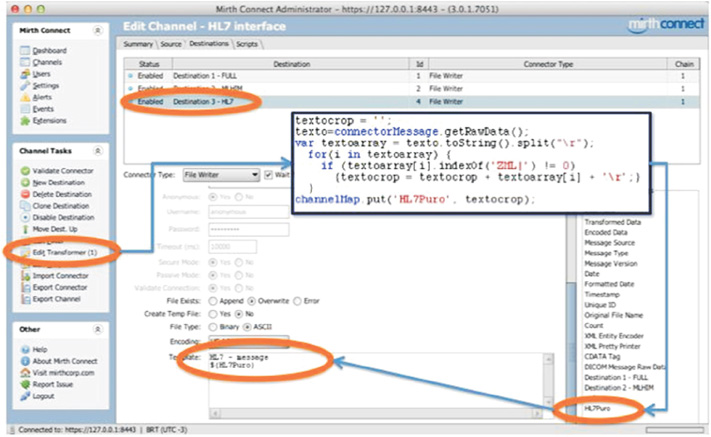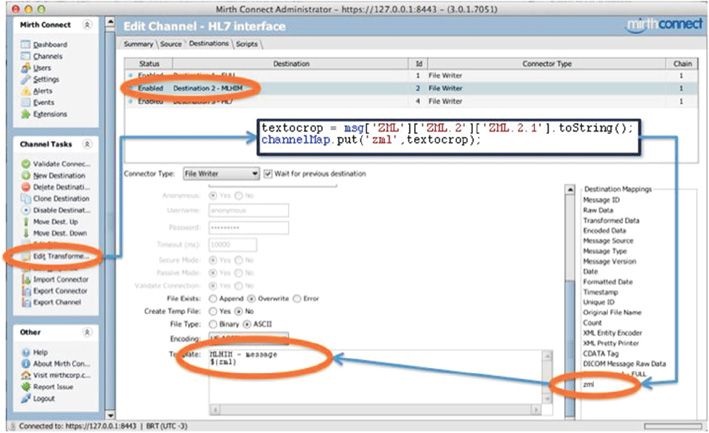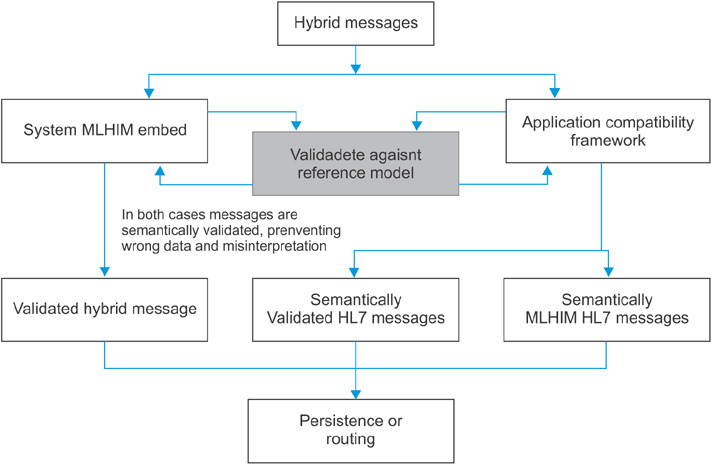Healthc Inform Res.
2016 Jan;22(1):22-29. 10.4258/hir.2016.22.1.22.
Convergence of Health Level Seven Version 2 Messages to Semantic Web Technologies for Software-Intensive Systems in Telemedicine Trauma Care
- Affiliations
-
- 1Post-Graduation Program in Civil Defense and Security, Rio de Janeiro, Brazil. pedromonteiro@gmail.com
- 2Emergent Group for Research and Innovation on Healthcare Information Technology, Rio de Janeiro State University, Rio de Janeiro, Brazil.
- 3Department of Epidemiology and Biostatistics, Fluminense Federal University, Niteroi, Brazil.
- KMID: 2166913
- DOI: http://doi.org/10.4258/hir.2016.22.1.22
Abstract
OBJECTIVES
To present the technical background and the development of a procedure that enriches the semantics of Health Level Seven version 2 (HL7v2) messages for software-intensive systems in telemedicine trauma care.
METHODS
This study followed a multilevel model-driven approach for the development of semantically interoperable health information systems. The Pre-Hospital Trauma Life Support (PHTLS) ABCDE protocol was adopted as the use case. A prototype application embedded the semantics into an HL7v2 message as an eXtensible Markup Language (XML) file, which was validated against an XML schema that defines constraints on a common reference model. This message was exchanged with a second prototype application, developed on the Mirth middleware, which was also used to parse and validate both the original and the hybrid messages.
RESULTS
Both versions of the data instance (one pure XML, one embedded in the HL7v2 message) were equally validated and the RDF-based semantics recovered by the receiving side of the prototype from the shared XML schema.
CONCLUSIONS
This study demonstrated the semantic enrichment of HL7v2 messages for intensive-software telemedicine systems for trauma care, by validating components of extracts generated in various computing environments. The adoption of the method proposed in this study ensures the compliance of the HL7v2 standard in Semantic Web technologies.
Keyword
MeSH Terms
Figure
Reference
-
1. Lenz R, Reichert M. IT support for healthcare processes: premises, challenges, perspectives. Data Knowl Eng. 2007; 61(1):39–58.2. Broy M. The 'grand challenge' in informatics: engineering software-intensive systems. Computer. 2006; 39(10):72–80.
Article3. De Leon S, Connelly-Flores A, Mostashari F, Shih SC. The business end of health information technology: can a fully integrated electronic health record increase provider productivity in a large community practice? J Med Pract Manag. 2010; 25(6):342–349.4. Raths D. Shifting away from silos: the interoperability challenges that hospitals face pale in comparison to the headaches plaguing state departments. Healthc Inform. 2010; 27(1):32–33.5. Hufnagel SP. Interoperability. Mil Med. 2009; 174(5S):43–50.
Article6. Blobel BG, Pharow P. Analysis and evaluation of EHR approaches. Stud Health Technol Inform. 2008; 136:359–364.7. Blobel B. Ontologies, knowledge representation, artificial intelligence: hype or prerequisites for international pHealth Interoperability? Stud Health Technol Inform. 2011; 165:11–20.8. Lopez DM, Blobel B. Architectural approaches for HL7-based health information systems implementation. Methods Inf Med. 2010; 49(2):196–204.
Article9. Quinn J. An HL7 (Health Level Seven) overview. J AHIMA. 1999; 70(7):32–34.10. Ingenerf J, Kock AK, Poelker M, Seidl K, Zeplin G, Mersmann S, et al. Standardizing intensive care device data to enable secondary usages. Stud Health Technol Inform. 2012; 180:619–623.11. Kalra D, Beale T, Heard S. The openEHR Foundation. Stud Health Technol Inform. 2005; 115:153–173.12. Cavalini LT, Cook TW. Use of XML Schema Definition for the development of semantically interoperable healthcare applications. In : Gibbons J, MacCaull W, editors. Foundations of health information engineering and systems. Heidelberg, Germany: Springer-Verlag;2014. p. 125–145.13. Saleem JJ, Russ AL, Neddo A, Blades PT, Doebbeling BN, Foresman BH. Paper persistence, workarounds, and communication breakdowns in computerized consultation management. Int J Med Inform. 2011; 80(7):466–479.
Article14. Moulton SL, Haley-Andrews S, Mulligan J. Emerging technologies for pediatric and adult trauma care. Curr Opin Pediatr. 2010; 22(3):332–338.
Article15. Cavalini LT, Cook TW. Knowledge engineering of healthcare applications based on minimalist multilevel models. In : Proceedings of IEEE 14th International Conference on e-Health Networking, Applications and Services (Healthcom); 2012 Oct 10-13; Beijing, China. p. 431–434.16. National Association of Emergency Medical Technicians. PHTLS: prehospital trauma life support. 8th ed. Burlington (MA): Jones & Bartlett Learning;2014.17. Health Level Seven International. Section 2.5.2 Segments and segment groups [Internet]. Ann Arbor (MI): HL7 International;2012. cited at 2015 Dec 20. Available from: http://wiki.hl7.org/index.php?title=Section_2.5.2_Segments_and_segment_groups.18. Ceron JD, Gomez GA, Lopez DM, Gonzalez C, Blobel B. A personal health record system for diabetes care conforming to the ISO 16527 interoperability requirements. Stud Health Technol Inform. 2014; 200:49–55.
- Full Text Links
- Actions
-
Cited
- CITED
-
- Close
- Share
- Similar articles
-
- Telemedicine in the U.S.A. with Focus on Clinical Applications and Issues
- The Development of a Graphical User Interface Engine for the Convenient Use of the HL7 Version 2.x Interface Engine
- Evolving Software Architecture Design in Telemedicine: A PRISMA-based Systematic Review
- Key Aspects of Using Web-based Diabetes Telemedicine Systems in Multiple Clinical Settings
- The IT Industry’s Influence on Next-Generation Aviation Technologies




